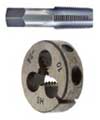
Threads 101
| Working
with toy steam engines from different countries can become very
confusing, American engines will have UNC threads, British will have
Whitworth and German will have Metric as a general rule. To further
complicate matters many engines sold previous to the first world war
were manufactured in Germany for the American and British markets.
The "Unofficial Mamod and Other Steam Engines" has a lot of information in their Steam Reference Library, provided by members, as to the style of threads used on most popular brands. You will have to register to access this information but it is painless and well worth it. The standards used for threads by the different countries and how they arrived at them is a very complicated subject and not really necessary here, a Google search will provide many pages of information. I have endeavored to provide a general guide to the various types of threads you will encounter. UNC (Unified Coarse) screws are based on gauge and threads per inch, so a 2-56 would be a #2 gauge screw with 56 threads per inch.
SAE Threads SAE, the Society of Automotive Engineers, sets standards for strength, hardness, thread profile etc. As this is a US based originazation most of the bolts in the USA and Canada follow this standard. SAE Threads Per Inch And Tap Drill Size Chart
MTP (Model Tapered Thread) MPT (Model Pipe Thread) or MTP )Model Tapered Thread) is a standard used for many toy and model steam engines, the most common size is 1/4" either in 32 or 40 TPI. The size is based on the OD (Outside Diameter) of the pipe.
NPT (National Pipe Thread) is a U.S. standard for tapered threads used to join pipes and fittings. The taper on NPT threads allows them to form a seal when torqued as the flanks of the threads compress against each other, as opposed to parallel/straight thread fittings or compression fittings in which the threads merely hold the pieces together and do not provide the seal. However a clearance remains between the crests and roots of the threads, resulting in a leakage around this spiral. This means that NPT fittings must be made leak free with the aid of thread seal tape or a thread sealant compound. The size is based roughly on the ID (Inside Diameter) of the pipe.
The BA system is named after the British Association for Advancement of Science. Screws were described as "2BA", "4BA" etc., the odd numbers being rarely used. While not related to ISO metric screws, the sizes were actually defined in metric terms, a 0BA thread having a 1 mm pitch. BA threads have diameters of 6 mm (0BA) and smaller and are mostly used in precision machinery.
I have included the table below as a rough indication of the size of BA screws expressed as a fraction of an inch, this is for visual identification only.
BSW (British Standard Whitworth) are the original, 19th Century, coarse-threaded industrial bolts designed to hold locomotives together. Because of their coarse pitch, they are more prone to vibrating loose, so are little used on automotives, except for threading into aluminum (e.g. crankcase studs), where a coarse thread is less prone to stripping. Except for 1/2" (where the British use 12 threads per inch (tpi) and Americans use 13 tpi) the thread pitches for the rest are the same as for American Unified Coarse (UNC). The thread form is different; Whitworth is 55 degrees; UNC is 60 degrees, however mismatched nuts and bolts mate nicely, so it is not uncommon to find UNC bolts or studs where BSW should have been or vice versa.
BSF (British Standard Fine) since 1908, in conjunction with BSW (British Standard Whitworth) has been the mainstay of British Engineering, and is used when finer pitches are required.
Metric screws are based on diameter in millimeters and thread pitch, the distance between threads in millimeters. So it follows that a M3.5 X 0.6 has a diameter of 3.5 mm and a pitch of 0.6mm.
I have included the chart below to compare Metric sizes to UNC, this is not to say they are inter-changeble but to give an idea of size to those of you familiar with one or the other.
The simpliest way to cut threads is with a tap or a die, taps are used for internal threads, dies for external. This is a link to another site of mine that goes into detail on how to use taps and dies. Threads are also cut on Screw Cutting Lathes, which is what most lathes on the market today are with the exception of a couple brands of hobby lathes. Threads can be cut by hand on the hobby lathes using adapters that hold a tap or die. Threads are easily identified with this handy thread gauge, simply dill holes in a strip of material then insert screws and fasten with a washer and nut. Place a second loose nut on each screw to be easily removed to check screw threads. Nuts are checked by threading them on to the screws. Make a gauge for each type of thread that you often encounter. Another method to measure threads in a small hole is to whittle a piece of soft wood to fit the hole and thread it into the hole, remove it and count the marks on the wood against a ruler. For a very comprehensive page of thread guides click here. |

